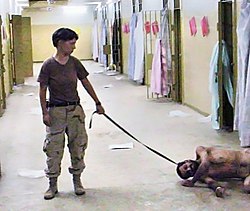Detentions and imprisonment
Initial detentions
Soon after the attacks of September 11, 2001, the United States government began detaining people who fit the profile of the suspected hijackers: mostly male, Arabic or Muslim noncitizens. By late November 2001, more than 1,200 people had been detained[ where? ] and held incommunicado.
Guantanamo camps

A major U.S. detainment facility is in Guantanamo Bay, Cuba. The facility is operated by Joint Task Force Guantanamo since 2002 at Guantanamo Bay Naval Base, which is on the shore of Guantánamo Bay. [1] The detainment areas consist of three camps: Camp Delta (which includes Camp Echo), Camp Iguana, and Camp X-Ray, the last of which has been closed. The facility is often referred to as Guantanamo, or Gitmo. [2] [3]
After the Justice Department advised that the Guantanamo Bay Detention Camp could be considered outside U.S. legal jurisdiction, prisoners captured in Afghanistan were moved there beginning in early 2002. After the Bush administration asserted that detainees were not entitled to any of the protections of the Geneva Conventions, the U.S. Supreme Court ruled in Hamdan v. Rumsfeld on June 29, 2006, that they were entitled to the minimal protections listed under Common Article 3 of the Geneva Conventions. [4] Following this, on July 7, 2006, the Department of Defense issued an internal memo stating that prisoners would in the future be entitled to protection under Common Article 3. [5] [6] [7] The detainees held as of June 2008 have been classified by the United States as "enemy combatants".
On January 22, 2009, the White House announced that President Barack Obama had signed an order to suspend the proceedings of the Guantanamo military commission for 120 days and that the detention facility would be shut down within the year. [8] [9] But as of January 2012, the Guantanamo camp is still operating.
On January 29, 2009, a military judge at Guantanamo rejected the White House request in the case of Abd al-Rahim al-Nashiri, creating an unexpected challenge for the administration as it reviews how America puts Guantanamo detainees on trial. [10]
As of January 6,2025 [update] , 15 detainees remain at Guantanamo Bay. [11]
President Barack Obama issued a Presidential Memorandum dated December 15, 2009, ordering the preparation of the Thomson Correctional Center, in Thomson, Illinois, so as to enable the transfer of Guantanamo prisoners there. [12]
Proceedings: Comparison with the American justice system
Broadly speaking, the United States has two parallel justice systems, with laws, statutes, precedents, rules of evidence, and paths for appeal. Under these justice systems prisoners have certain rights. They have a right to know the evidence against them; they have a right to protect themselves against self-incrimination; they have a right to legal counsel; they have a right to have the witnesses against them cross-examined.
These two justice systems are the judicial branch of the U.S. government, and a slightly streamlined justice system named the Uniform Code of Military Justice, or UCMJ, for people under military jurisdiction. People undergoing a military court martial are entitled to the same basic rights as those in the civilian justice system.
The Guantanamo military trials do not operate according to either system. The differences include:
- The accused are not allowed access to all the evidence against them. The Presiding Officers are authorized to consider secret evidence the accused have no opportunity to refute. [13]
- It may be possible for the commission to consider evidence that was extracted through coercive interrogation techniques before the enactment of the Detainee Treatment Act. [14] However, legally the commission is restricted from considering any evidence extracted by torture, as defined by the Department of Defense. [15]
- The appointing officer in overall charge of the commissions is sitting in on them. He is authorized to shut down any commission, without warning, and without explanation.[ citation needed ]
- The proceedings may be closed at the discretion of the presiding officer, so that secret information may be discussed by the commission. [16]
- The accused are not permitted a free choice of attorneys, as they can use only military lawyers or those civilian attorneys eligible for the secret security clearance. [17]
- Because the accused are charged as unlawful combatants, former Secretary of Defense Donald Rumsfeld stated that an acquittal on all charges by the commission is no guarantee of a release. [18]
